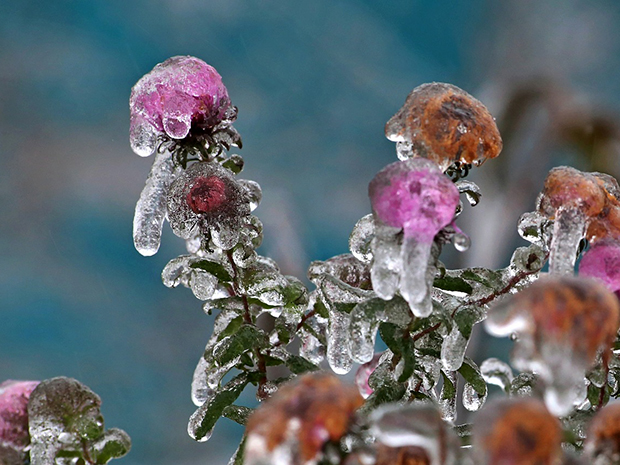Cut perennial foliage down to 2” to 3” inches of the ground except for Lavender, ornamental grasses, Russian Sage, Montauk Daisy and Mums. Also leave roses and Butterfly Bushes alone. You may choose to leave some perennials for winter interest and bird feed such as Sedums, Coneflowers, Black-Eyed Susans, Astilbes and Globe Thistle.
Mound soil or compost 6” to 10” around the base of the rose. Do this after several hard frosts and the ground is cooling down, usually in late November. You can also ‘box’ in roses with stakes and burlap, in addition to the mounding, for extra protection.
Old Garden Roses and tall shrub roses also benefit from roping twine around canes. This protects tall canes from being whipped around by winter winds and possibly snapped.
Winter care for flowering shrubs.
Keep flowering shrubs properly watered in fall. They need to be well hydrated before the ground freezes and shuts off their water supply. This is especially important for spring flowering shrubs that have set flower buds. If the plant is ‘parched’ going into winter, the buds are compromised and could lead to poor spring flowering.
In November place chicken wire around shrubs that are targets for winterkill, stress or frozen flower buds. Pack the interior of the hooped cage with raked leaves. Shrubs that benefit from this protective measure include Hydrangeas that bloom on old wood and Butterfly Bush.
In late November or early December spray anti-dessicant (Wilt-Pruf) on broad leaved evergreens like Rhododendron, Holly, Boxwood and Pieris (Andromeda).
Protect temperamental shrubs in windy areas with ‘burlap screens’ using wooden stakes and burlap. These can include bud-laden spring flowering shrubs or those that are borderline for your zone. For example, I put wind screens in front of threadleaf Japanese maples and ‘Carol Mackie’ Daphnes.
Plant spring, summer and fall blooming bulbs. Most people only plant spring blooming bulbs in fall but don’t stop there. Hand dig or drill (using a bulb auger) summer and fall bloomers too for three seasons of color.
Preserve tender bulbs, tropicals and annuals.
Tender plants need to be dug and stored.These include Tuberous Begonias, Dahlias, Gladiolas, Callas and Caladiums. Wait until right after the first frost, dig, cut back foliage, remove soil from bulbs, allow to air dry for a few days and store in a cool, dry place. They can be stored in peat moss, vermiculite, newspaper, brown bags or onion bags.
Containers of tropicals like Banana trees, Shield plants (Alocasia), Elephant Ears (Colocasia) and Agapanthus can be brought inside and grown as houseplants or allowed to go dormant in a cool, dry place like the basement. If these tender plants are in your perennial beds, then dig them up and either place them in a decorative container as a houseplant or allow them to go dormant in pots.
For annuals you want to carry over to the next year, take stem or root cuttings. You can also move annuals inside as houseplants. Make sure to wash off leaves with an insecticidal soap or soapy water to kill bugs.
Do a soil pH test if you haven’t done so for several years. Fall is a great time to apply lime or sulfur after foliage has been cut back.
Fall is the recommended planting time for Peonies, Oriental Poppies and German Bearded Iris.
To save a bundle of money, purchase marked-down perennials in containers and overwinter for next year’s use. Be sure to keep the potted plants consistently watered while they are still in active growth. In late October, cut back the plants in their pots. In late November give all pots a good drink of water and then cover with small squared chicken wire. This keeps voracious wildlife like chipmunks, voles and squirrels from eating the roots. If you want to further protect the plants, place mice bait between some pots. After securing the chicken wire, cover everything with tarp. Uncover in early April, depending on weather. If you have an unheated garage, shed or barn, then winter them over there and skip the tarp step.
If your soil needs improvement, apply nutrient-rich mulch such as compost or aged manures around the plants after cutting them back. This will start breaking down and enrich the soil through fall, winter and spring.
Many upright Arborvitaes, like ‘Green Emerald’, benefit from ‘cinching’ to reduce damage from snow and ice storms. In November circle twine around Arborvitae, winding it from the base to the top, and tie off.

